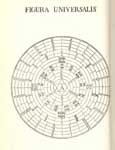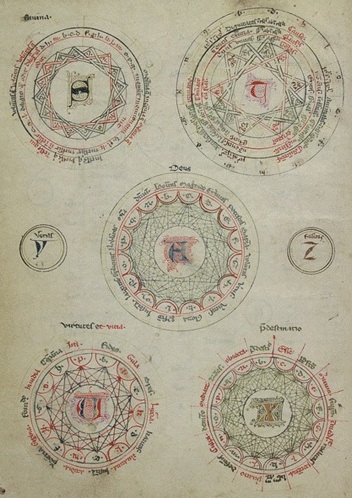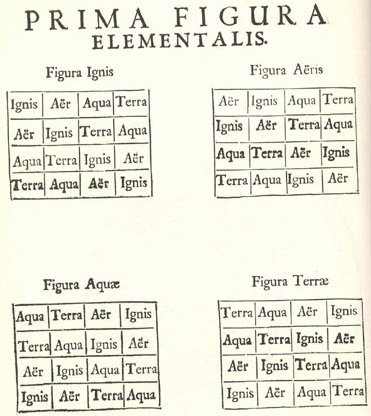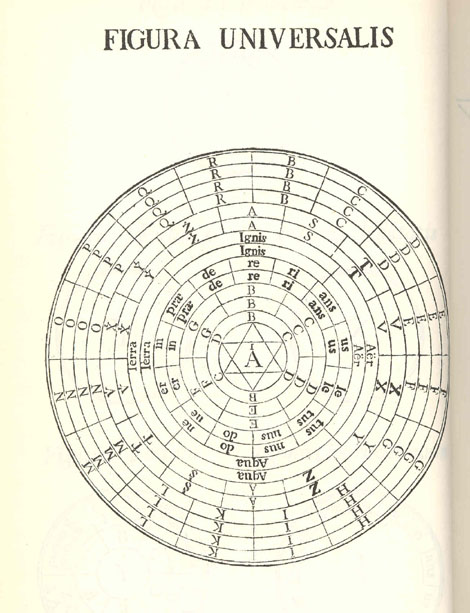

According to a http://quisestlullus.narpan.net/ web site:
"... The discovery of the Art was ... during a period of time devoted to contemplation on a mountain top, which tradition has identified as Randa, not far from the city of Majorca (Palma). ... the Lord suddenly illuminated his mind ... Ramon went straight away to an abbey and composed the book calling it at first Ars major, and later on the Ars generalis. The title of the work in which this first redaction of the Art took shape was the Ars compendiosa inveniendi veritatem (Brief Art of Finding the Truth). ... The Ars compendiosa inveniendi veritatem established the Figures and Alphabets of Ramon's method for the first time: it was the central work of the 'first cycle' of this phase ... (1274-1289) ... In the 'second cycle' Llull re-elaborated his system around the Ars demonstrativa (1283). The Art of the first phase is also known as 'quaternary' because certain series of principles were presented as multiples of four (groups of up to 16 principles). ...... The Ars demonstrativa ... was the second version of the Art, and revised and completed the Ars compendiosa inveniendi veritatem (1274). It belongs to the second stage of the first of the Art's phases and was composed in Montpellier in 1283. The work comes accompanied by Figures and an Alphabet; the former are graphic symbols which make the structural components of the Art visible and facilitate the operation of the combinatorial mechanisms and the calculations. ...
The Ars demonstrativa contains 12 'primary' figures, which Llull designates by letters. ...

... Except for the Elemental Figure, they are all circular and carry words inscribed around their circumference. The diametrical lines indicate the binary combinations of the concepts in question.
- Figure S focuses on the rational soul and is made up from four interlocking squares drawn inside a circle, each square representing a different combination of the acts of man's higher faculties ...
- Figure T consists of five interlinked triangles, each of a different colour, drawn inside a circle; it represents five triads of concepts: difference-concordance-contrariety (green); beginning-middle-end (red); majority-equality-minority (yellow); affirmation-doubt-negation (black); God-creature-operation (blue). ...
- Figure... Y ... represent[s] a single concept: truth
- Figure A represents God and sixteen of his attributes or dignities ...
- Figure... Z ... represent[s] a single concept: ... falsity ...
- Figure V exists in two colours: blue V represents the ...[seven]... virtues ... and red V the ...[seven]... vices ...
- Figure X contains eight pairs of opposing concepts ...
- The Figure of Theology ...
- the Figure of Law ...
- the Figure of Philosophy ...
- The Elemental Figure is formed by four rectangles which represent the binary combinations of the four elements starting from each element (fire, red; air, blue; water, green; earth, black). ...
- The Demonstrative Figure provides a semi-mechanical method for combining the concepts from certain figures with those from other figures. ...
Alongside the twelve 'Primary' Figures, the Ars demonstrativa includes ten 'Secondary' Figures. The 'Secondary' Figures have a triangular form and are tables of all the possible binary combinations of the concept from the 'Primary' figures. ...".
The correspondences of Figures S, T, Y, A, Z, V, and X with a realistic Unified Physics Model including Gravity and the Standard Model have been described in pdf papers at
The Figures of Theology, Law, and Philosophy seem to be mostly alternative labellings of the 16 vertices of Figure A in terms of those respective areas of discourse.
The Elemental Figure

is a set of four 4x4 Matrices with 4x4x4 = 64 dimensions, and so corresponds to the 4x4 Quaternionic Matrix Algebra M(4,Q) = Cl(2,4) and describes the Cosmology of our Universe.
If the entries Ignis etc were considered to be Quaternionic, then it would be the 256-dimensional 8x8 Quaternionic Matrix Algebra M(8,Q) = Cl(2,6), and Cl(2,4) would be half of its Even Subalgebra.
In terms of Quaternions q_mn (where m and n run from 1 to 4) with basis { 1, i, j, k } the 4x4 Quaternionic Matrix Algebra looks likeSince Spinors of the Clifford Algebra Cl(2,4) can be seen as rows of the M(4,Q) Matrix, they look like four Quaternions, and so are 4x4 = 16-dimensional, corresponding to the 8 first generation Fermion Particles and the 8 first generation Fermion Antiparticles and to the Real Spinors of the 16x16 = 256-dimensional Cl(8) Clifford Algebra that is represented by the 16x16 Real Matrix Algebra M(16,R).
Cl(2,4) has graded structure 1 + 6 + 15 + 20 + 15 + 6 + 1, where grade-0 scalars are 1-dimensional, grade-1 vectors are 6-dimensional, grade-2 bivectors are 15-dimensional, ... etc ...
The grade-2 bivectors of Cl(2,4) form the Lie Algebra of the 15-dimensional Conformal Group Spin(2,4) =SU(2,2) that was used by Irving Ezra Segal for Cosmology, and by Rabindra Mohapatra for a generalized MacDowell-Mansouri mechanism for producing Gravity. It has
- 4 Translations
- 3 Rotations
- 3 Boosts
- 4 Special Conformal Transformations
- 1 Dilation
It acts non-linearly on 4-dimensional Physical Spacetime, but linearly on the 6-dimensional grade-1 vector space of Cl(2,4).
- The 4 Translations in 4-dimensional Physical Spacetime correspond to Dark Matter Primordial Black Holes.
- The 3 Rotations, 3 Boosts, and 4 Special Conformal Transformations correspond to the Aldrovandi-Peireira Cosmological Constant Cone-Space and to Dark Energy.
- The1 Dilation, with 1 dimension of scale and 0 vector dimensions, corresponds to the Higgs mechanism and to the mass of Ordinary Matter.
Calculations in a realistic Unified Physics Model give
The Demonstrative Figure is a simpler version of the Figura Universalis:

Llull's 4 Outer Rings (Rings 1, 2, 3, 4) each have 16 subdivisions and correspond to
16 is the dimension of the Spinor Space of Cl(8) = M(16,R) and the Real Spinor Repesentation of Spin(8), and of the Spinor Space of Cl(2,4) = M(4,Q) and the Quaternionic Spinor Representation of the Conformal Group Spin(2,4) = SU(2,2).
There are 16x16 = 256 possible combinations and ( 16 2 ) = 16x15 / 2 = 120 combinations of 2 distinct elements.
There are 16x16x16x16 = 256x256 = 65,536 = 2^16 possible combinations, and ( 16 4 ) = 16x15x14x13 / 2x3x4 = 1,820 combinations of 4 distinct elements.
Llull's Rings 5 and 6 each have two sets of 7 subdivisions, explicitly corrresponding to
There are 14x14 = 196 possible combinations and ( 14 2 ) = 14x13 / 2 = 91 combinations of 2 distinct elements.
Llull's Rings 7 and 8 each have 4 subdivisions, explicitly corresponding to the 4 Elements: Fire; Air; Water; Earth.
There are 4x4 = 16 possible combinations and ( 4 2 ) = 4x3 / 2 = 6 combinations of 2 distinct elements. 6 is the dimension of the Lorentz Group Spin(1,3). 16 is the dimension of the Spinor Space of Cl(8) = M(16,R) and the Real Spinor Repesentation of Spin(8), and of the Spinor Space of Cl(2,4) = M(4,Q) and the Quaternionic Spinor Representation of the Conformal Group Spin(2,4) = SU(2,2).
Llull's Rings 9 and 10 each have 13 subdivisions, corresponding to the 13 Concentric Rings of the Figura Universalis itself.
There are 13x13 = 169 possible combinations and ( 13 2 ) = 13x12 / 2 = 78 combinations of 2 distinct elements. 78 is the dimension of the Lie Group Spin(13) and the exceptional Lie Group E6.
Llull's Rings 11 and 12 each have 6 subdivisions: 3 BDF corresponding to the Yang /\ triangle of the Star of David and 3 CEG corresponding to the Yin \/ triangle of the Star of David. The Yin and Yang correspond to Llull's wheels Y and Z.
There are 6x6 = 36 possible combinations and ( 6 2 ) = 6x5 / 2 = 15 combinations of 2 distinct elements. 15 is the dimension of the Conformal Group Spin(2,4) = SU(2,2).
Llull's Ring 13 has 6 subdivisions corresponding to the 6 vertices of the Star of David, which can be seen as two triangles corresponding to Llull's wheels Y and Z.
According to Anthony Bonner's book Doctor Illuminatus (Princeton 1993):
"... Aside from the ... Franciscan and generally medieval-Christian aspects of Llull's mysticism, there ...[were]... two other major influences on Llull - that of the Muslim mystics (the Sufis), and that of Troubadour poetry. ... In the history of Western mysticism, there is nothing quite like ... the Book of the Lover and the Beloved [written during the first cycle (1274-83) of Llull's Quaternary Phase (1274-89)]... with its curious blend of Troubadour, Franciscan, and Islamic influences, mixed with Llull's own special outlook based on the Art ...Llull's first teaching experience at the University of Paris ... the greatest center of Western learning in the Middle Ages ... in 1288-89 must have been disheartening. ... As in any structured academic or intellectual world, Paris had its fashions as to topics discussed, modes of discussing them, and the vocabulary used. All of these were far removed from ... Llull['s] ... method - the Art - which resembled nothing anybody had ever seen before, and employ[ed] a vocabulary that must often have seemed bizarre. ...
Llull ... felt that it was important for the achievement of his goals to get the backing of the French court and the University of Paris as representing the political and intellectual centers of Europe. ...
Even ...[Llull's]... disciple, le Myesier, complained ... about "the confusion caused by the meanings of the alphabet of the Ars demonstrativa and its sixteen figures, which confound the mind." ...
Llull ... tr[ied] to persuade the Parisian schoolmen ...[by]... us[ing] the bizarre vocabulary more sparingly, and modify[ing] the Art itself so that it would not look so alarming. ... Towards the beginning of 1290 in Montpelier, therefore, Llull set about ... beginning a new phase of the Art ...
As a result of the "weakness of human intellect", the number of figures [wa]s reduced and the algebraic notation vanishe[d] ... the only figures left [we]re A and T ... With the Demonstrative Figure ... resurfacing, transformed into the new Third and Fourth Figures ...[so that the total number of]... the figures w[as] reduced from twelve to four. ...
Figures A and T .. were reduced to nine components each. This involved a loss of seven dignities of Figure A, and two of the triangles of Figure T. ...
Llull's last works were written in December 1315 in Tunis, at which point he disappears from history. ... he must have died sometime between then and March 1316 ...
the Dominican inquisitor general of Aragon, Nicholas Eymerich (1320-99), began a campaign against the doctrines of Ramon Llull ...[that]... culminated ... in two events:
The first was the publication in January ... 13676 ... of the Directorium inquisitorum, his notorious manual on inquisitorial methods ... it contained a list of a hundred errors of Ramon Llull ... on February 6, a papal bull was promulgated censuring Llull and condemning twenty of his books ... Llull's followers ... won in 1416 ... the promulgation by the Papal Court ... invalidating the bull of forty years earlier. ... Veneration of Llull was ... permitted withn the Franciscan Order and locally in Majorca ... his feast day was set on 3 July ...
The second condemnation of Llullist doctrines came from ... the Faculty of Theology of the University of Paris. In 1390 ... the Faculty of Theology publish[ed] an edict prohibiting the teaching of Llullist doctrines. ...[It]... cut off ... considerable interest in Llull in Paris ..[and also]... forced serious thinkers concerned with his doctrines ... to disguise this fact in their writings. ... Nicholas of Cusa (1401-64) seldom mentioned Llull in his writings ... Even though he ... copied, collected, and annotated ...[a]... large collection of Lullian works ...[and]... Many aspects of Llull's thought entered his philosophy and theology ...
Giordano Bruno (1548-1600) ... wrote no less that seven works specifically on the Lullian Art. ... Frances A. Yates , Giordano Bruno and the Hermetic Tradition (London, 1964; Chicago, 1978) ... said ... that Bruno even mentioned "among those who in solitude have achieved the vision and gained marvelous powers, Moses, Jesus of Nazareth, Ramon Llull, and the leisured contemplators amongst the Egyptians and Babylonians." ...
Leibniz's Dissertatio de arte combinatorica, published in 1666 when he was only twenty, ...[was a]... serious attempt to reform the Lullian Art. ... Leibniz's interests in a universal language, encyclopedism, and a general science constituted the side of his thought that was a continuation of Renaissance endeavors and that ultimately stemmed from Llull's Art as a system which would provide a key to universal reality. ... ".
Frank Dodd (Tony) Smith, Jr.
April 2007
( for further material and details, and for references and source material, see my web site at www.valdostamuseum.org/'hamsmith/ or mirror site at www.tony5m17h.net/ the contents of which are hereby incorporated herein by this parenthetical reference )